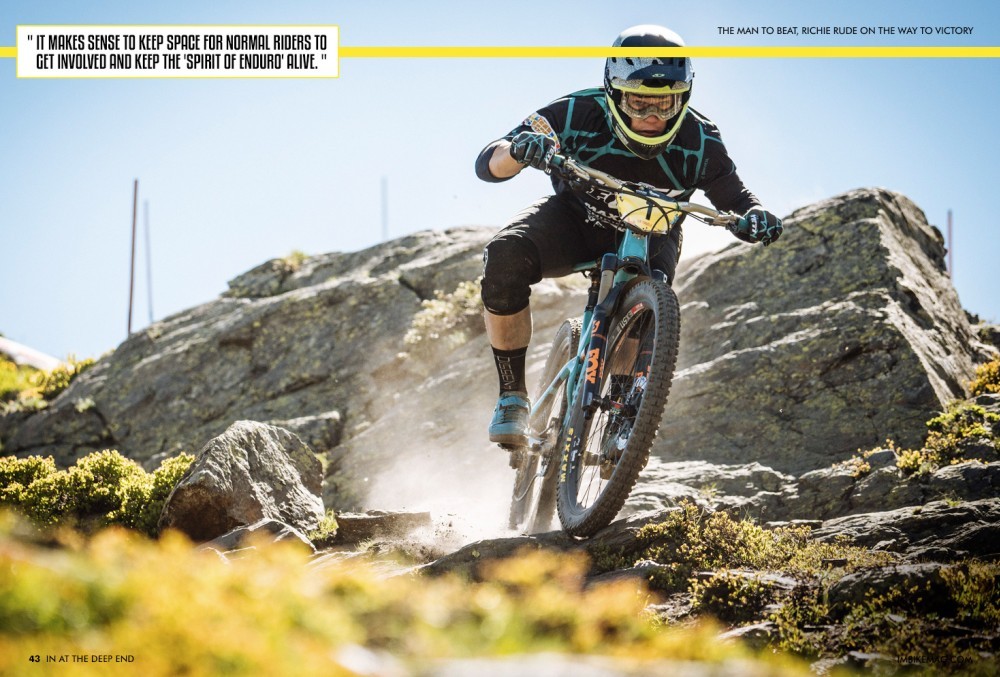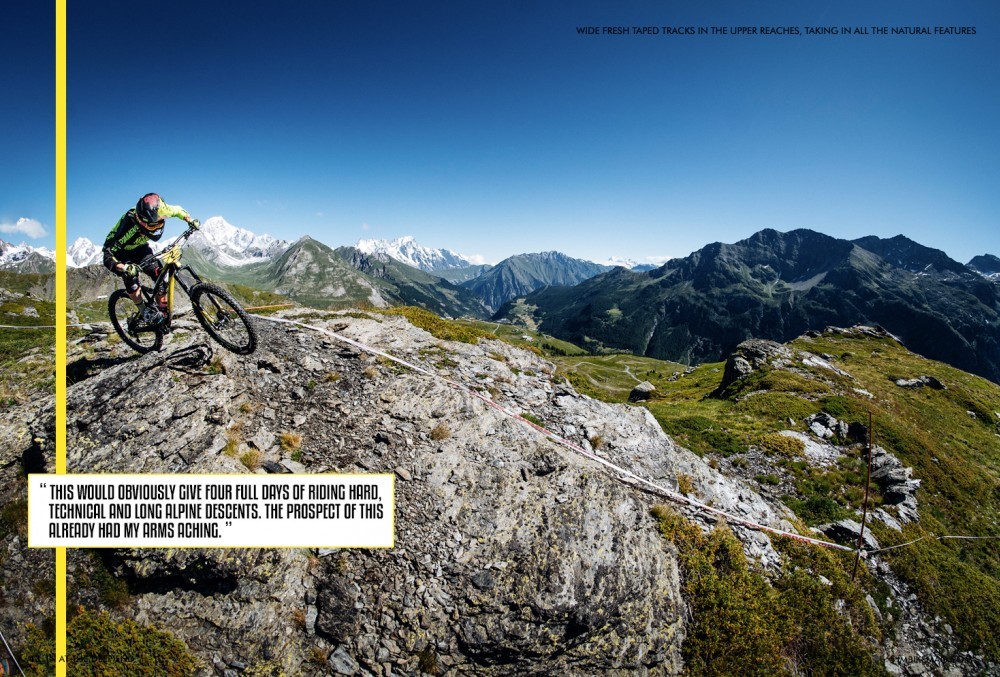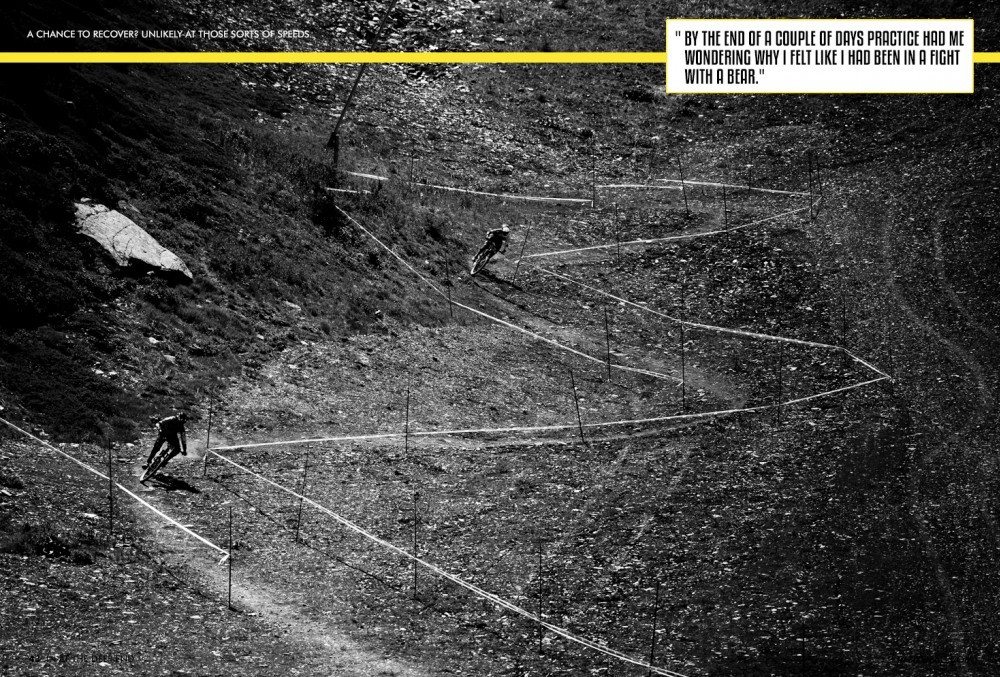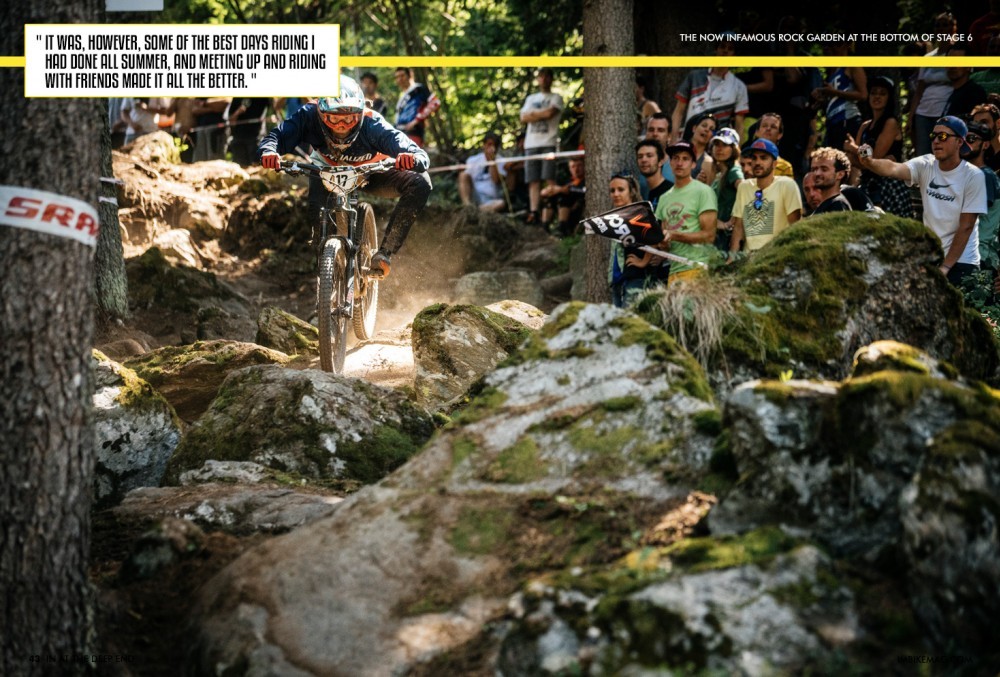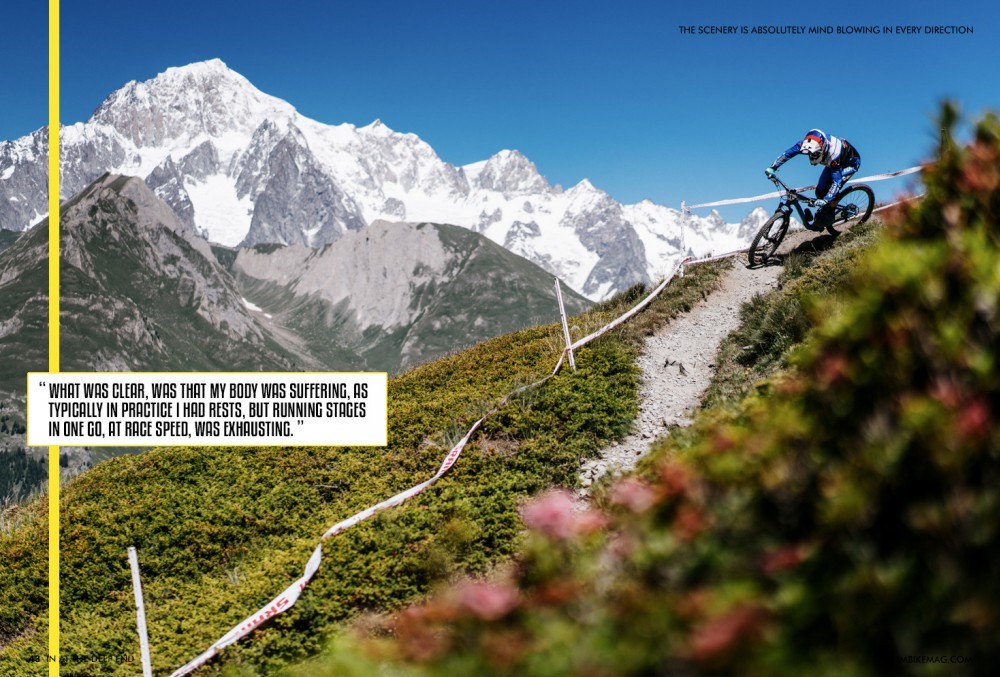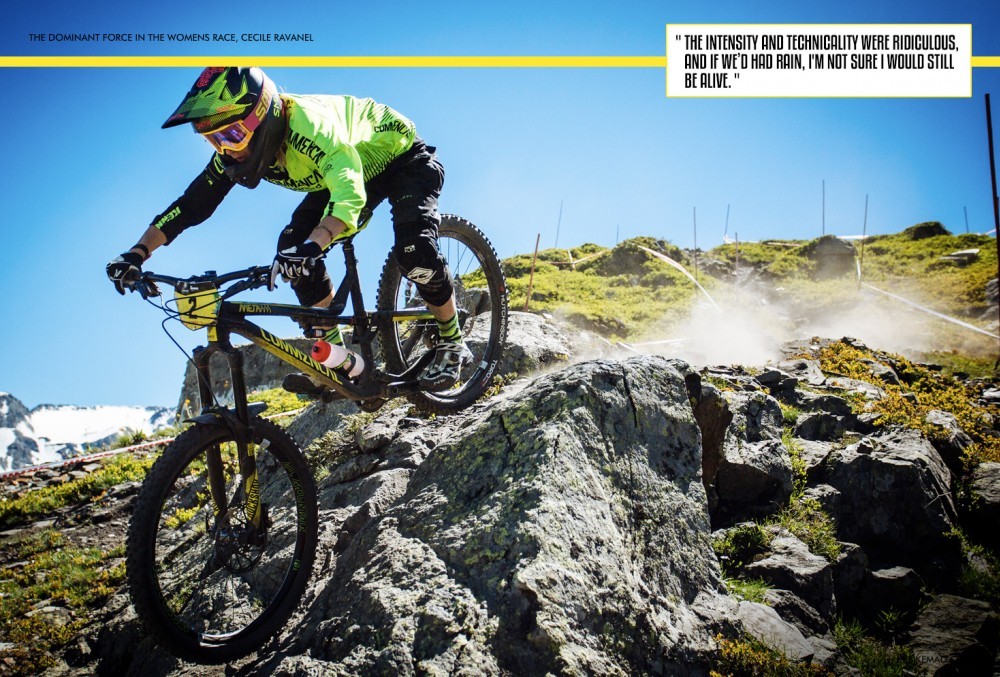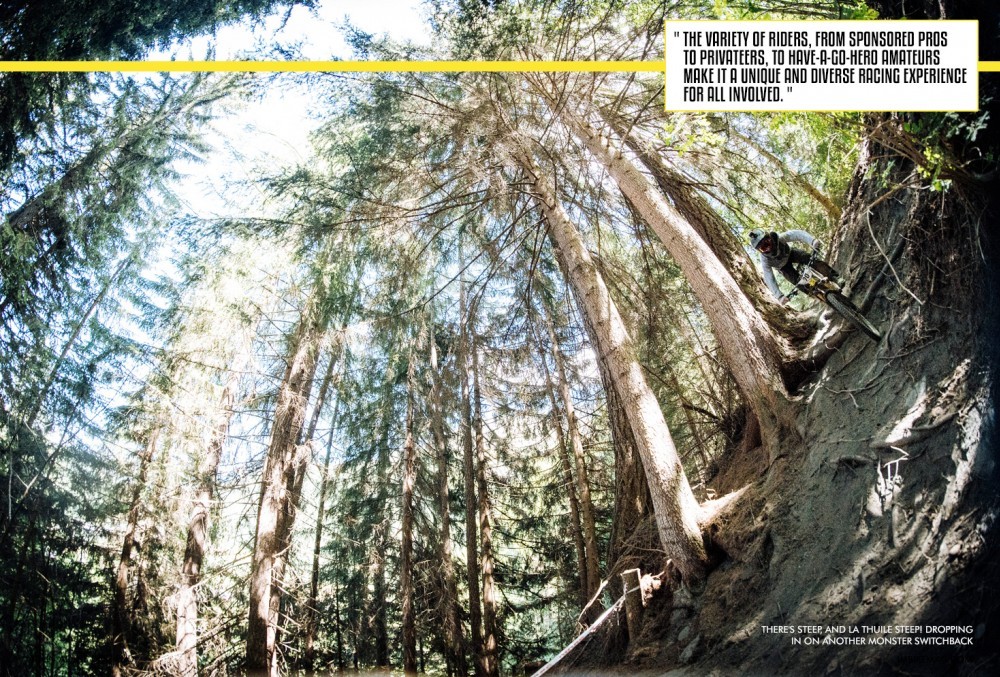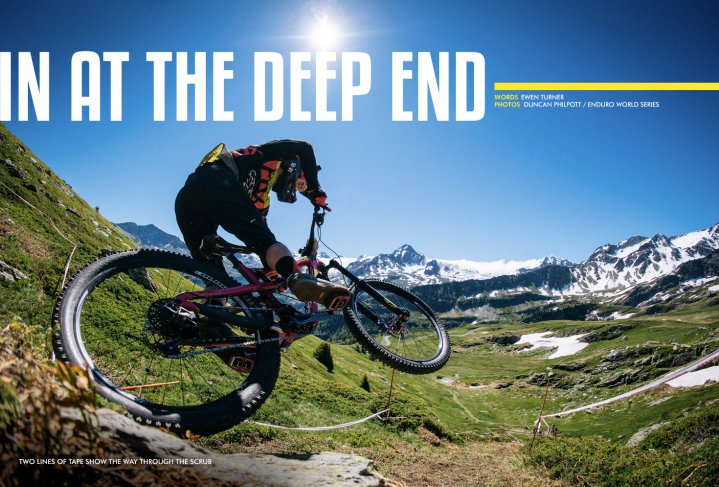
In At the Deep End
Issue 43 / Mon 22nd Aug, 2016
Ewen Turner jumps head first into the Enduro World Series to see if he can survive world class riding at the highest level and finds out how it feels to race as an amateur on the world stage.
Head First
As I hit my head on the canopy out of the start hut, I'm instantly reminded that I might be punching a little above my weight. Only mildly disconcerted, I continue, safe in the knowledge that Greg Minnaar did the same thing at Leogang last year at the World Cup, so I'm in good company. It's not until I am lying on the ground after only the second corner that the evidence is starting to build up, suggesting that maybe entering a round of the Enduro World Series might have been foolhardy, especially at one of the most notoriously tough and technical rounds on the circuit.
You might well be asking how an amateur such as myself ended up in this position, but the beauty of the EWS is the ability for mortals to throw their proverbial hat in the ring, and enter the lottery for a chance to ride. Earlier this year, the entries opened, and hopeful racers from around the world dutifully filled in the online entry form and waited expectantly to see if they had been one of the lucky ones. With a vast field of professionals, there aren’t a large number of amateur places, but the opportunity is there, which is great. You don't get that at the downhill World Cup!
The World Series works on visiting existing events throughout the globe and playing by the 'house' rules of that nation's race. For instance, the La Thuile race features mostly lift-accessed trails, whereas Finale features all pedal accessed stages. These races already existed in some form before the EWS came to town and were supported by racers of all standards, so it makes sense to keep space for normal riders to get involved and keep the 'spirit of enduro' alive.
Nestled in the northern corner of Italy, La Thuile is a beautiful mountain resort, famous for fantastic skiing. Unlike some parts of the Alps, which can feel like concrete has been poured liberally around mountains in a race to create skiing infrastructure, the Aosta region of Italy retains a sense of history and culture. The villages and towns although highly developed for skiing have a permanence and history about them, suggesting they've survived in these mountains for many years, and will continue to do so forever.
Into the Deep
My attempt at mixing it with the best in the world couldn't be much further from the professional race teams that rolled into the sleepy little Italian Alpine resort. I had my family in tow and would attempt to juggle racing with time spent on the swings in the playground. The race was based around the resort, and the main features were two chair lifts and one enormous road climb. The schedule included two days of practice followed by two days of racing, with stage one to three practice on Thursday, four to six on Friday. These two days would then be repeated at the weekend for the race proper. This would obviously give four full days of riding hard, technical and long alpine descents. The prospect of this already had my arms aching.
Although it was intimidating to be queuing up for number boards and lift passes with some of the best riders in the world, the feeling around the resort was more one of fun and excitement. With the British so keen on spending summers in the Alps, it wasn't long before I'd bumped into a bunch of friends and arranged for some practise laps. Surrounding myself with familiar faces, I felt less worried about the prospect of dropping into some world-class tracks.
The first glaring reminder of my amateur status was the number of team vans driving up the road climb to the first stage. Having underestimated quite how long the transition would be, and not having anyone spare to give us a shuttle, we winched up the road to the trailhead to meet a bunch of fresh looking riders being dropped off. All perfectly within the rules, but you need to have a spare driver. The second half of the climb took us off road and up into the vast open mountains overlooking Mont Blanc, or Monte Bianco depending on one's perspective or nationality.
Stage one was the only big pedalling transition, the rest of the stages being lift accessed with minimal effort, which, by the end of a couple of days practice had me wondering why I felt like I had been in a fight with bear. The answer lies in the sheer brutality of the tracks, not only in their rough, technical nature, but the incredible length, and therefore time spent hanging on. This is all before you add in a few punchy climbs here and there to push you over the edge (metaphorically speaking).
The stages were a mix of wide open fresh cut trails in the upper reaches of the mountains, featuring rock slabs and steps interspersed with wide flat corners cutting through the scrubby vegetation. These required riders to be constantly vigilant for sniper rocks sticking out or emerging as the dry conditions and hundreds of wheels continuously altered the course, and new lines formed. The lower sections of the trails fell into the alpine single track category, with turn after turn through the woods. These sections would either be rocky and loose, requiring careful judgement of traction, or so steep and loamy that faith in the catch berms was the only thing to hope for, as brakes and control of speed were unlikely to be a factor.
The practice days went by in a blur of switchbacks and rocks, with plenty of time spent on the ground wondering how I got there, and emptying loam and pine needles from my underwear. It was, however, some of the best days riding I had done all summer, and meeting up and riding with friends made it all the better. This level of fun and enjoyment I was not expecting to be in such ready supply at a race like this. Although both pros and amateurs are in attendance, there are also those who operate in the middle ground, up and coming riders looking to make their mark on the world stage. With the likes of Cube rolling into town with an 'all singing and dancing' team truck, there are still privateers out there living in vans, doing their own spannering and surviving on a minimal budget. The range of riders, support and aspirations are huge.
Staying Afloat
As fate would have it, I was seeded next to my friend Simon from back home, so I had a partner in crime for the weekend of racing. Being pretty low in the seeding, we were sent off early in the morning and were greeted with the huge road climb like a slap in the face. This is the unglamorous side of enduro racing, the slow inevitable winching up mountains to reach the stages where the racing is won and lost.
As previously described, my start to stage one was less than perfect, but after picking myself up, things got going properly, and I didn't embarrass myself any further. As the first stage of the day, there is always a worry that you'll be caught, but the seeding (however that was done) seemed to work, and I didn't get in anyone's way. What was clear, was that by body was suffering, as typically in practice I had rests, but running stages in one go, at race speed, was exhausting.
The weekend continued in a blur of aching limbs, and a brain that felt like it could barely process any more turns or any more rocks. Having not been listening carefully enough to the rather dull but essential riders briefing, Simon and I managed to focus more on the feed station than getting our time-check done on the first day and headed off to stage three. On return, we were chastised like naughty schoolboys by a grumpy Italian and ended up with a thirty-second penalty and a slapped wrist.
We doubted a penalty of this size would have much effect on our results, and a few pros were caught out too, which made us feel a bit better. Having already stuck my race stickers in the wrong place I was keen to keep things on track. Simon, however, kept the comedy of errors coming with a forgotten lift pass, which incurred further Italian wrath. Apparently, a number board was not enough evidence that he was in the race! A quick run to the office sorted him out and made it in time for the next stage. Despite further issues including fading brakes, lost chains and a flat tyre, we both made it round in one piece and even survived stage six.
Stage six gets a special mention as one of the steepest trails I have ever raced. Although only dropping from the first lift, the intensity and technicality were ridiculous, and if we’d had rain, I'm not sure I would still be alive. On top of all the other riding in the previous days, it became a battle just to hold on and stay on course, rolling into the finish with seventy-five minutes of racing to my name. We had both survived, proof that it can be done.
The Other End of the Spectrum
Although wrapped up in our little battle of survival, at the other end of the spectrum was another race, this time for the place on the top step of the podium. Team support, mechanics, GPS tracking, this is the high-performance end of the race, with eye-wateringly quick times on the same stages, which in comparison, I had just been trundling down.
Richie Rude and Cecile Ravanel, proving once again that they are a force to be reckoned with, dominated the race. The steep alpine trails appealed to them, but as the season progresses, it's clear they can win on any track. Sam Hill was hot on the heels of Rude, rocking his flat-pedal style, but couldn't close the gap, which left a minute and a half between them. The downhiller certainly seems to be making waves in the enduro world and making the enduro specialists take stock as he blasts the competition to pieces.
In the women's race, Cecile got off to a rocky start on stage one as Jared Graves got in the way while inspecting the course and took her out. It's reassuring to know it doesn't always go right for the top riders. Obviously frustrating, Cecile went on to win every stage and finish with a two and half minute lead, cementing her dominance at the top of the overall. Another dominant force was present in the under 21s category in the form as Adrien Dailly, whose winning time would have him the senior men’s top ten!
On The Horizon
With the series in full swing, thoughts already turn to the overall and last round in October. As I write this, the Aspen round has finished, and Whistler is on the way, with these rounds then followed by a return to Europe for Valberg and the grand finale in Finale. Aspen has seen Ravanel's winning ways continue unabated, and despite Rude's injury, he still holds onto the overall. It would be a risk to bet against either of these two for the overall win, but with several rounds still to go, anything could happen.
What will be certain is the quality of the racing, trails and riders who make these events so special. The variety of riders, from sponsored pros to privateers, to have-a-go-hero amateurs make it a unique and diverse racing experience for all involved. With the advent of qualifying races for the EWS, we could see a more formal route to the World Series which can only help the up and coming racers to get a foot on the ladder. Hopefully, this won't come at the expense of the amateur racers who want to get involved, and a balance can be found so the 'Spirit of Enduro' can continue to flourish.
Videos
By Ewen Turner
Ewen Turner is a self-confessed bike geek from Kendal in the Lake District of England. He runs a coaching and guiding business up there and has a plethora of knowledge about bikes with an analytical approach to testing. His passion for bicycles is infectious, and he’s a ripper on the trails who prefers to fit his working life around his time on the bike.




